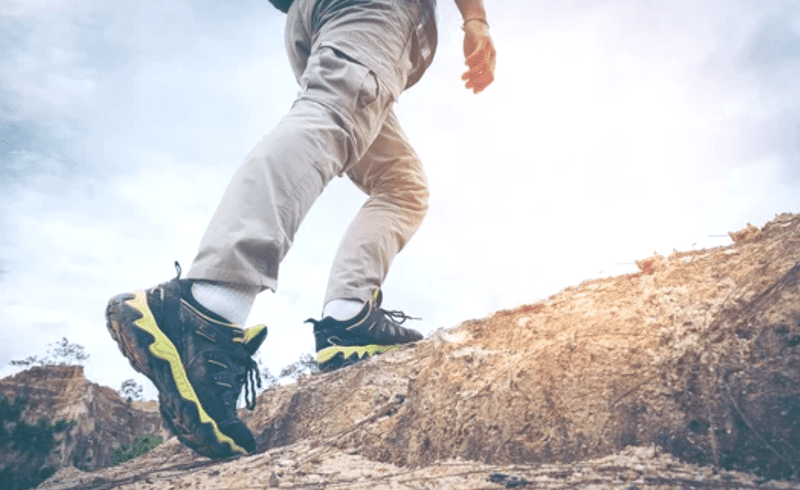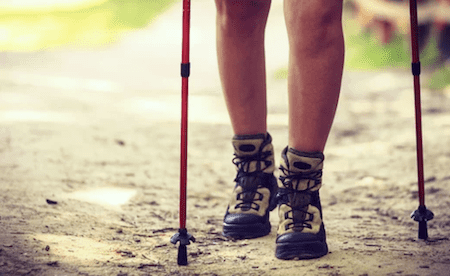Hiking is one of the sporting activities that can be undertaken by the youth and elderly persons. It is also suitable for families and groups of people of all age sets. It is a vigorous walk on a footpath around a mountain, lake, or countryside.
Hiking has positive effects on physical fitness and may not require special equipment. To make hikes successful, the hikers must be prepared to cover as many kilometers as possible.
Hiking in groups is the best option for any person. It allows them to do plenty of things, including exercises and sightseeing together. It also allows the hikers to engage in activities that make the process of hiking a trail full of fun.
Some of the hiking activities you are likely to engage in include climbing mountains, accessing snowfields, and glaciers. It may also include snowshoeing, cross-country skiing, and backpack camping.
But to succeed as a hiker, it requires that you develop endurance to allow you to walk over long distances without getting tired.
If you are not used to walking long distances, you may find this adventure difficult.
Also, it may be difficult for you to reach the summit hence denying you the fun. So it would help if you learned some of the tricks you may need to use to preserve energy.
But walking for a long distance without getting tired may be achieved through regular physical training and exercising.
The training bit makes the muscles less stiff and enhances the hiking experience.
It also allows you to have more fun as you trek for more kilometers. However, you need to preserve energy to allow your legs to cover more kilometers.
Here are some of the things you may do to help you preserve energy while on a hiking trail.
21 Ways To Preserve Your Energy While Hiking
#1. Treat Your Muscles
Once the muscles get tired, it becomes difficult for you to continue indulging and enjoying the beautiful outdoor activities. Thus, it may be necessary to treat the muscles in advance to prepare them for the hiking adventure.
Proper treatment of the muscles before you embark on the adventure could spare you from muscle fatigue.
Here, you may use medication to help the muscles to relax. It reduces muscle stiffness and will prepare them to handle the ups and down activities of hiking.
#2. Rest Before The Hiking Day
You need to be relaxed on the day you take on the hiking trail. So plenty of sleep could help your body relax. Also, it helps it to preserve energy levels and get prepared for the journey ahead.
#3. Nutrition
The body and the muscles need fuel to effectively engage in hiking activities. If you fail to supply the muscles with the right nutrients, they will not be in the right shape to endure strenuous hiking activities.
However, this does not mean that you feed on McDonald’s every after a few hours. You need to eat food that is loaded with carbohydrates but which contains high levels of glucose.
It would help if you also carried some high energy levels to supply the legs with the energy it needs to keep you going.
#4. Stretching
Your muscles need to be stretched to the limit to increase their resilience. Also, you need to pull them apart so that they get stronger and bigger. Rigorous stretching prepares the muscles for the hiking activities ahead.
It gives them enough strength to carry you along the terrain. Also, stretching consistently will give the muscles the endurance you need to trek.
Besides stretching, you need to engage in yoga to help the body get harder and withstand fatigue. It gives it the power it needs to go on.
#5. Take Shorter Strides
Once you have done several miles of hiking, your muscles will start giving in. At this point, you will need to take shorter steps. It is one of the strategies runners employ to outpace their competitors.
It helps you control your pace and reduces the pressure on the legs, especially if going downhill. Also, it allows blood to circulate through the entire body. Good circulation of blood carries oxygen to all parts of the body.
#6. Make Use Of Breaks
You must test your endurance a few days before the hiking day. It allows you to test your strength and plan ahead. Once you have determined the number of hours you can hike, ensure to punctuate them with breaks.
If you can hike for two hours continuously, take a break every two hours. It helps the body to recover. What’s more, is that It will allow you to last longer on the trail. Breaks of between 1 and 20 minutes will suffice.
#7. Drink Enough Water
Although drinking enough water is common sense, most hikers ignore it. When they do this, it becomes difficult for them to hike. The muscles lack lubricants and stick together.
Walking becomes painful, and the hikers find it hard to complete the expedition. Also, the lack of water causes the muscles to become stiff. It makes it difficult for the muscles to glide past each other.
This is what makes the hikers wear down fast and unable to complete the trek. But drinking enough water can help preserve energy and hike more.
However, the water source may not available on your hiking trail. So, carry a sufficient water bottle.
#8. Exercise And Practice
Exercising for a few weeks before the material date is key to successful hiking. It helps the body to endure many hours of walking or standing.
It also helps the body to find the center of gravity and maintain a straight posture while walking. This is vital since it reduces the pressure one exerts on the back.
Furthermore, it makes hiking easier and more enjoyable. But the hiker must always target exercises that exert pressure on leg muscles.
It plays a role in minimizing the pressure exerted on joints.
#9. Choose Appropriate Gears
One thing that people forget is that wearing the right gear makes hiking adventurous. It ensures that you maintain your posture and it reduces injuries.
Improper footwear should be discouraged since it is likely to throw you off balance. In most cases, it results in accidents.
Ensure to wear boots designed for hiking activities.
Also, remember to wear compression pants since they play a role in helping the blood circulate around the body. Lastly, it helps the muscles to glide over each other easily to accelerate the movement.
#10. Don’t Just Keep Hiking
Taking a rest when the legs give in is necessary. It gives them the break they need to relax. Also, it can help one to gather the strength they need to allow you to embark on the trail once again.
Resting helps the muscles to recover and prepares the brains for the trailhead. It preserves energy and makes trailing enjoyable.
#11. Cycling
Cycling could greatly help you develop endurance. But to get the best results, you must start slowly. The speed is not important, so try to cycle as much as you can every day at least two weeks before the hiking date.
Also, you may run uphill regularly a few days before you go hiking. If you cannot run, take a walk in the park to help the heart and the lungs get used to trekking.
Choosing a Favorable Circuit Some circuits are favorable, while others are too technical. But the ultimate goal of hiking is to reach the highest point of the circuit.
So, you will need to pick a less technical circuit to help you preserve energy. Do not choose a circuit because your friends will be hiking on it.
Do some research from the guides and discover circuits that are favorable. A steep circuit will leave you tired after a short while. It means that you may not be able to cover a long distance.
As such, it is prudent that you choose a relatively flat circuit. It helps you to preserve more energy and will help you to hike more.
#12. Determine A Sustainable Pace
The problem that most hikers face is that they try to walk at the pace of their friends. This is dangerous since you may not be as fit as your friend. Therefore, you must determine your own pace.
It helps you to preserve energy and reduces the chance of getting tired. Copying your friend’s pace will make you get fatigued in no time.
Also, walking at a faster pace will tire you after a short while. It may force you to take a break means that you may need to take more time to complete the journey.
But trekking at a reduced pace allows you to walk for many hours. So if you are in a group, the team leader must reduce the pace so that they accommodate all the people hiking.
Also, walking at a slower pace will enhance your safety if the terrain is unforgiving. Furthermore, it will allow you to look at the surrounding areas and enjoy the beauty.
A beautiful landscape will psychologically prepare the body. It will give it the energy it needs to complete the trail.
#13. Discover Your Rhythm
Other than the pace, you need to find your rhythm while hiking. It will help you stay energized and enjoy the hiking adventure. Choose a pace that you are comfortable with and which will give you the strength you need to endure.
Remember, hiking is fun and should not be treated as a race. As such, you will need to plan your hike and discover the rhythm that can help you endure hiking for many hours.
Choosing a friendly rhythm is vital since it is key to successful trekking. Do not rush and follow the rest of the team blindly.
#14. Avoid Shortcuts
Although we have said here that you must choose a favorable circuit, it does not mean that you go for shortcuts. Typically, shortcuts are always steeper and will make you tired.
Indeed, steeper shortcuts will get you tired after covering a short distance. Hence, avoid shortcuts because you may need to use more energy to hike to the top of the mountain.
Also, you may try to avoid steep slopes by moving in a zigzag.
#15. Use Hiking Poles
There is a myth that hiking poles are meant for older people. This is not true since they are designed to make hiking easier for everyone. Also, they are efficient and will allow you to expend less energy while hiking.
Good hiking poles will allow you to walk a longer distance without getting tired. They are efficient and designed to help users use less energy as they move up the terrain.
Besides, they will enable you to keep the body balanced all through. Furthermore, hiking poles will make you spend less energy and will relieve the knee joints from unnecessary pressure.
Also, they will help you maintain your balance when climbing steep terrain. notice that the hiking poles will help you to easily gain your balance and not to fall when trekking on slippery ground.
It reduces the energy you expend, and you will not get tired quickly.
#16. Stay Hydrated
You need to drink at least 4 liters of liquids before, during, and after hiking. So you may need to plan and vary the drinks according to your taste. But ensure to include water, soup, and juice.
Hydrating yourself reduces muscle pain. It also reduces heavy legs, and you will feel ok after hiking.
So, before you start the hiking excursion, ensure to carry a straw or a hose to allow you to take regular sips from the backpack as you walk.
#17. Eat Nutritious Foods
Eating a nutritious breakfast is vital since it prepares the body for the hike. Fluids containing fast sugars are the best.
Also, ensure that you eat starch and protein-giving foods. Carry a few of chocolates but ensure that they do not contain too much sugar.
Prepare your favorite food for lunch but have starchy foods as well as salads, protein, and vitamin-giving foods with you. Besides, add some natural fats like ham or salami.
#18. Walk Light
Going hiking requires that you only carry a lightweight pack. A heavy pack will add unnecessary weight to your body and will only help you get tired faster. Just pack a few staff you will need while hiking.
A bottle of water and some bars of chocolate will be enough for you. But remember to pack your favorite lunch. Also, you may need to think out of the box when choosing hiking shoes.
Heavy boots are not the best because they will slow you down. Besides, do not wear heavy clothes since they tend to restrict movement. However, expect the weather to get windy and cold as you move towards the peak of the mountain.
Note that a heavy backpack will make you feel shriveled and may slow you down. You will be tempted to throw it away and continue with the hiking. If not, it will tire you and slow you down.
A light pack will make you feel comfortable and will encourage you to walk more.
#19. Deep Breathing
This is an important technique that helps the body to relax. It will make you feel less tense and allow you to breathe easily. Also, deep breathing will re-energize your muscles and allow you to push more on the trail.
Therefore, ensure you engage in deep breathing anytime you feel that you are getting tired. It will give you the extra energy you need to hike for a few more hours.
#20. Snack While Hiking
As you prepare for the adventure, you must think about the foods that you will need to use and carry to give you more push. The foods you take or carry must contain carbohydrates, vitamins, fats, and protein.
Besides, they must be able to give you the energy you need to keep you on the trail. For vitamins and fats, choose dried beans, trail mix, and beef jerky. For carbohydrates, the pasta will do.
However, it would help if you remembered that you would only need to take a snack when the body demands food. Also, eat enough to replace the lost energy.
#21. Help The Body To Heal
After hiking, you will need to do some stretching. It helps the muscles to relax and gather more energy. Drinking some beer in the evening will lessen the pain and make the muscles relax.
If you don’t like beer, you may consume some yeast. But if the pain persists, you will need to use aspirin or paracetamol.
In some cases, a few people may develop crumbs. This may occur as a result of losing mineral salts and excessive sweating. If it happens to you, taking an isotonic drink may help you.
Also, bananas could be the best option for you. They contain potassium that helps the muscles to relax and heal quickly.
Final Verdict
Of course, there are many other things you may need to do to preserve energy while hiking. However, doing it in the wrong way can cause personal injury.
Choosing the right pace and exercising a few weeks before hiking will help you more. Also, remember to hydrate and to treat the muscles before and after hiking.


